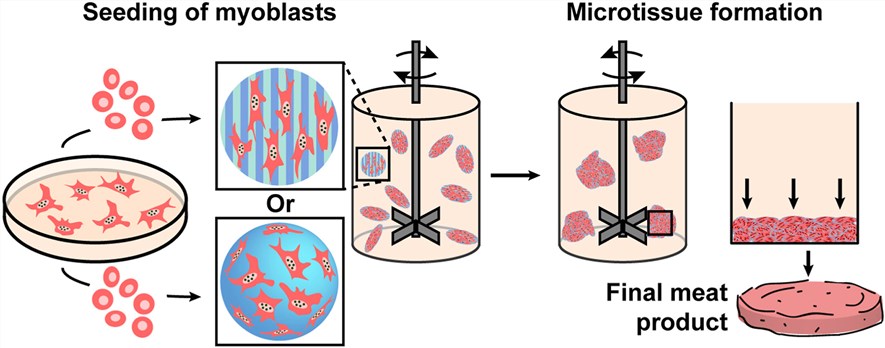The system of choice for large-scale mammalian cell culture is the ubiquitous stirred tank reactor in which anchorage-dependent cells are grown in suspension on microcarriers in the culture medium. Microcarriers have a large surface area/volume ratio and are the most promising candidates for muscle cell culture. Microcarriers are typically 100-200 μm in diameter and vary in physical properties such as porosity, density, size, stiffness, and surface chemistry. However, many microcarriers have been developed for cell lines and stem cells typically used in the medical field. None have been developed specifically for muscle stem cells and meat production. Commercially available microcarriers often lack the structural stability required for stirred cell cultures and are expensive non-food grade polymers. Degradable and edible microcarriers are being explored to separate cells from inedible microcarriers.
 Fig.1. Application of emulsion template particles with tunable stiffness and topology as edible microcarriers for cultured meat. (Norris S C P et al., 2022)
Fig.1. Application of emulsion template particles with tunable stiffness and topology as edible microcarriers for cultured meat. (Norris S C P et al., 2022)
For decades, advances in our tissue engineering and biomaterials approaches have made possible the generation of skeletal muscle tissue on a laboratory scale in vitro. Yet innovations in production efficiency are needed to make cultured meat a viable protein substitute. One effective strategy is to adapt cells for growth in suspension in bioreactors. Lifeasible attempt to develop microcarriers to support the proliferation and differentiation of various types of animal cells in a scalable manner. The optimal biomaterial used in the design of microcarriers for cultured meat production should be able to mimic the natural 3D networks that provide structural support and maintain normal cell behavior in muscle cells. We use edible polymers that can be used as substrates for cell expansion, including but not limited to:
We aim to develop edible microcarriers with tunable mechanics and surface topology for expanded cultured meat production. Working closely with biomaterials scientists, our team of experts develops customized processes for edible microcarriers for cultured meat.
(1) Preparation of edible microcarriers.
(2) Characterization of edible microcarriers.
(3) Analysis of the potential of edible microcarriers to support cell expansion.
(4) Analysis of the potential of edible microcarriers to support cell differentiation.
(5) Evaluate the ability of edible microcarriers to support cultured meat generation.
The role of each specific material in the microcarrier requires us to be very innovative in the development phase to achieve each customer's individual goals. Our labs rigorously test various materials and components to obtain more scalable and cosmetically pleasing cultured meat. Microcarriers will continue to be modified to support the diversity of cell types and meat products to be manufactured in the future. We guarantee you obtain edible microcarriers at competitive prices, with short turnaround times and reliable results. Feel free to contact us for more information.
Reference
Lifeasible has established a one-stop service platform for plants. In addition to obtaining customized solutions for plant genetic engineering, customers can also conduct follow-up analysis and research on plants through our analysis platform. The analytical services we provide include but are not limited to the following:
STU-CRISPR System Improves Plant Genome Editing Efficiency
April 19, 2024
Application of Exosomes in Facial Beauty
April 12, 2024